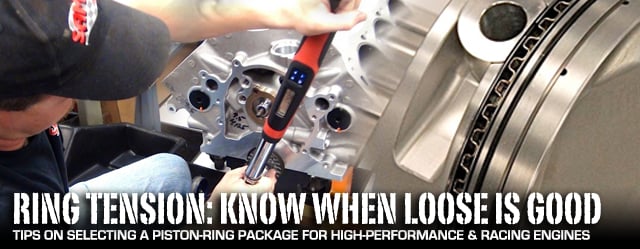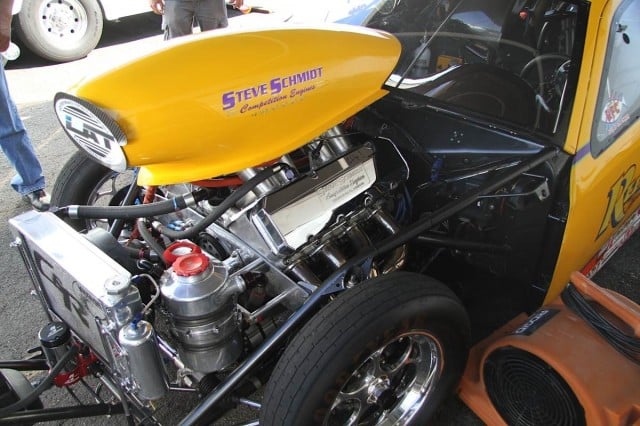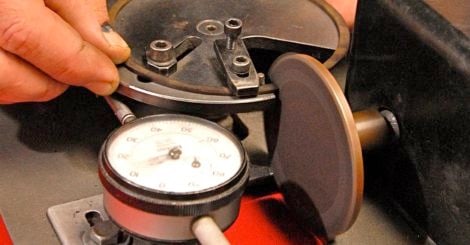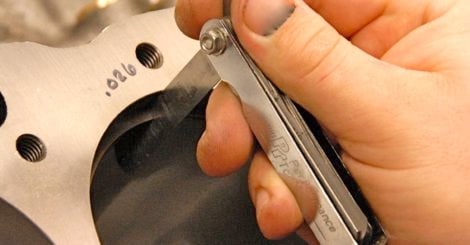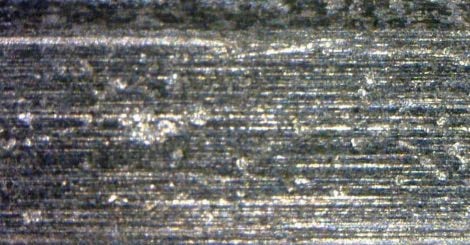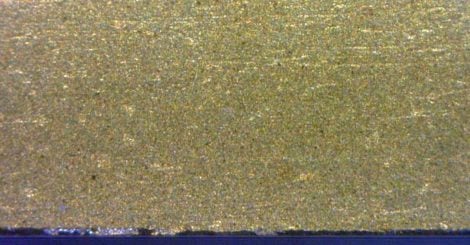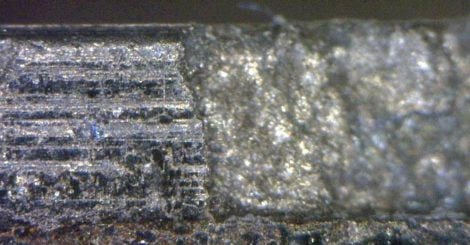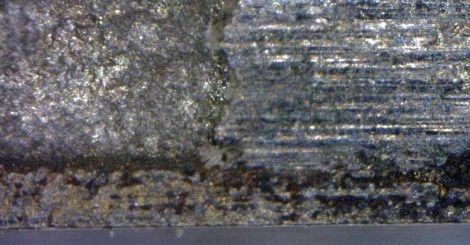It’s irritating when small elements of an engine get slightly out of whack and result in ruinous consequences. Fortunately, it’s also true that when you get the small details right, every cylinder sings in perfect harmony.
Take piston rings, for example. Get ring tension right and you’ll collect free horsepower and promote long engine life. Get it wrong, and you’ll end up with a short-lived engine that never achieves full potential.
How can piston rings have so much influence over an engine? Easy. The ring package can account for around 37 percent of the total friction in the motor. To break it down further, internal friction losses from all sources can amount to 40 percent of total brake horsepower, and pistons and rings account for 50 percent of that loss. So ring friction by itself can account for up to 15 percent of brake horsepower.
Ring-tension demands are very different between naturally aspirated and boosted engines, even in similar high-performance venues.
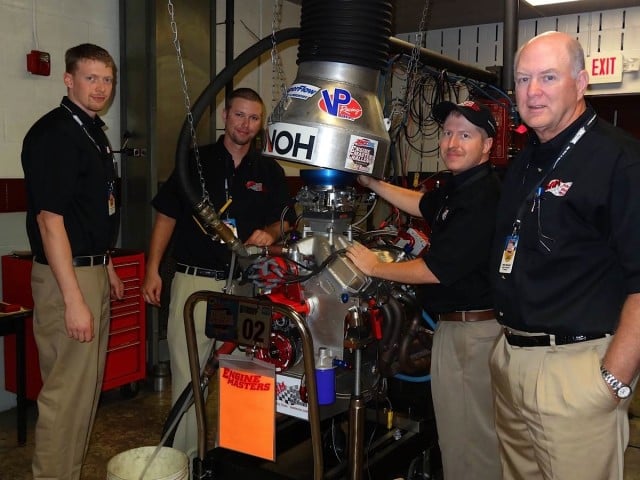 [4]
[4]The School for Automotive Machinists (SAM) has been drifting away from moly coatings on many high-performance projects. That's Judson Massingill on the far right.
Judson Massingill at the School of Automotive Machinists [5] in Houston is in a perfect position to offer an inside perspective to the variables in piston-ring tension. SAM-built powerplants won the Engine Masters Challenge Street Division in 2011 and the Xtreme Street Division in 2012.
“In competition like that, ring tension is incredibly important,” says Massingill.
There are logical considerations in selecting are proper ring package, but also plenty of variables. Ring suppliers, therefore, want to know all the particulars about the engine and its use.
“We invite the end users to call and discuss their specific applications to assure they are getting the best package,” says Keith Jones, technical advisor at Total Seal [6].
Erring on side of caution
A street motor will typically use standard tension oil rings. A ring supplier may recommend a package that errs on the side of caution, with ring tension slightly on the high side. This may cost a little horsepower; but if the rings don’t have enough tension, oil can reach the combustion chamber and cause a variety of problems. There a completely different checklist when dealing with competition engines.
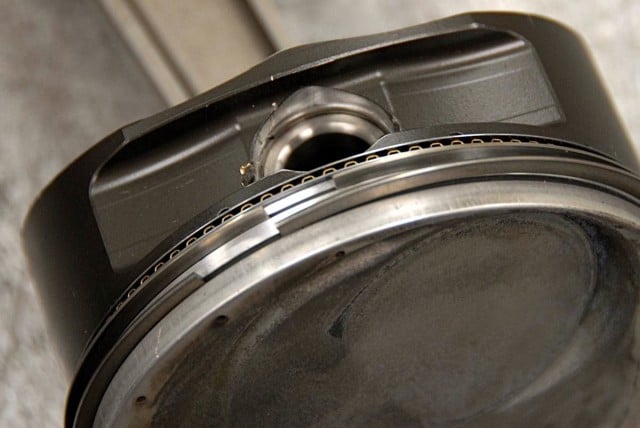 [7]
[7]Note the gas ports on the piston top. Chris Bennett, an instructor at SAM, also points to the high position of top ring land. While some say lateral gas ports are better, most Pro Stock and NASCAR pistons have vertical gas ports.
“Then you have to establish if this engine is going to be a wet sump or a dry sump,” explains Massingill. “For dry sump, you can run a lower tension oil ring because there’s going to be less oil from the windage splashing it around in the motor.”
“The vacuum will let you reduce the ring tension. That’s because you’re going to have less atmospheric pressure in the crankcase,” adds Massingill. “The oil will not stay in suspension as much, it will fall down easier. There’s not as much splash on the pistons. So we can run lower tension with a dry sump or a wet sump with vacuum pulled.”
“Not all oil pans, pumps and windage trays are created equal,” adds Jones. “Do your research before making a purchase. Some work very well, some can make it worse. But anything to reduce crankcase pressure, windage and splash is a good thing.”
When comparing the differences in piston-ring metallurgy, the top and second rings get all the attention as they protect the oil ring from most of the extreme heat and combustion pressure.
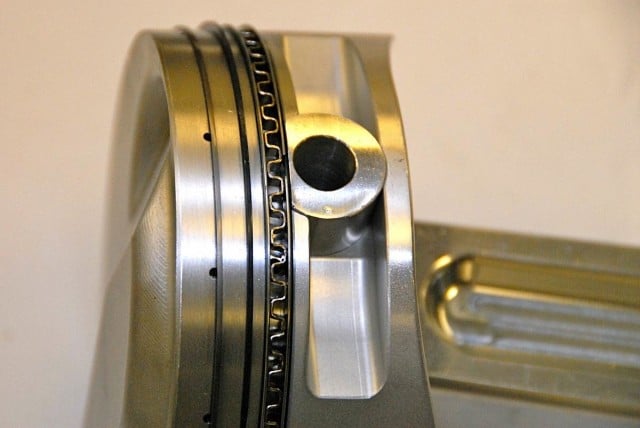 [8]
[8]Here's a piston for a 2,000-horsepower nitrous application with lateral gas ports. Note that the wrist pin intrudes into the oil ring groove and the use of a button to help keep the wrist-pin in place. The button won't dislodge because it's held in position by the cylinder wall and the oil-rail support.
“The top ring is going to shield the second one,” says Massingill. “So our top ring is the most important, by far, for having the good material.”
Massingill notes that it may be controversial to some, but, “The second compression ring is as much or more an oil ring than it is a compression ring. It scrapes oil that gets past the oil ring.”
“Second rings are dual purpose,” echoes Jones. “They help aid the top ring and the oil ring, acting as a back-up plan for both.”
The majority of rings are cast, usually one of two types: grey iron cast and nodular cast. It’s not uncommon to find both types in the same ring pack. Even in a factory high-performance engine there can be nodular top and cast second.
“The nodular cast is about two to three times greater tensile strength,” adds Massingill. “When you buy the $39 rings, the top and second are both going to be grey iron rings. When you move up to the $100 ring sets, you’re going to get a nodular top and a cast second. Even at 1,000 horsepower you will see a cast second quite often. The general jump up from there is to some type of steel ring. It may be tool steel, it may be another alloy of steel.”
Why move away from moly coatings?
Ring coatings are another factor to consider. Moly is a common face coating and has been in use for decades. It has both good and bad selling points. On the good side, it’s porous and helps hold oil, meaning it’s very forgiving of different cylinder finishes. A big responsibility for any honed finish is to create a surface that will hold the right amount of oil for a specific application. Remember, rings and pistons ride on a film of oil just like a bearing on a crankshaft. Too much oil and it just gets burned away. Not enough and there’s potential for metal-to-metal contact with pending disaster.
“You hear the term ‘moly ring.’ The ring is not moly. The coating on the ring is moly,” explains Massingill. “The moly ring is the most popular by far, until around 800 to 1,500 horsepower.”
Proper piston installation includes file-fitting the ring ends to ensure the proper gap.
“High cylinder pressures dictate steel rings,” says Massingill, whose been shifting away from moly rings on school projects. “Today we’re running rings much, much thinner than we did five to seven years ago. And when you make the rings smaller, obviously the cast ring will not stay in one piece. So we have to get to steel, even on some lower horsepower engines if we’re going to run the very thin rings.”
Ring flutter
With the power adder, the fact that we go to a smaller ring and pick up 20 horsepower is of little consequence on an 1,800-horse motor.
— Jud Massingill
Advances in machine tooling technology have paved the way for thinner piston rings in modern times. Among other benefits, thinner piston rings address an old problem—ring flutter, which occurs when the rings, usually at high rpm, start to vibrate within the ring grooves.
“Everybody worries about the ring sealing on the cylinder walls,” says Massingil. “But if ring doesn’t seal on the bottom of the ring groove, that’s just as bad. So when it goes into flutter it comes off the bottom of the ring groove and you have no sealing.”
Massingill says he has observed on the dyno the effect of ring flutter— the engine revs, the crankcase pressure goes positive and power goes off a cliff.
“It’s simple physics. If the ring is lighter, it will go faster before it starts fluttering,” says Massingil.
“Thinner and lighter rings also conform to bore distortion created by the pressures in the cylinder better than thicker rings,” adds Jones.
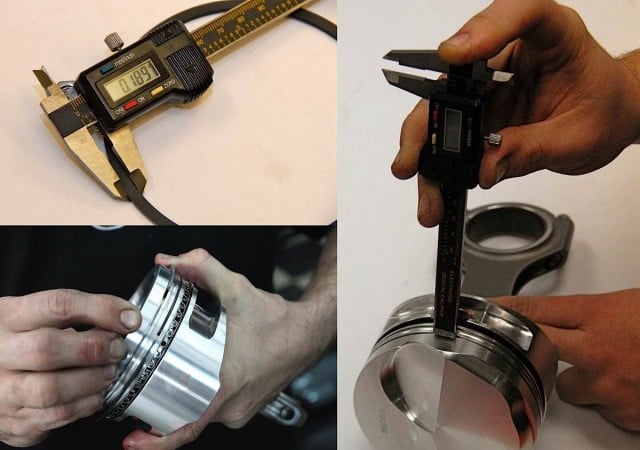 [11]
[11]Total Seal says the rings should never, under any condition, be exposed when bottomed out on the groove. Here, the ring width is measured and compared with the groove depth to determine the back clearance
There are times, however, when the thinnest ring is not the best choice. In those instances, usually a power adder is in the mix. At the highest levels, the average power adder motor won’t turn the rpm a naturally aspirated engine will, which lends itself well to running a thicker, more robust ring. High-end power adder applications in this instance can be defined as something like a 500-horsepower shot of nitrous or 25 pounds of boost.
“When you get to that kind of cylinder pressure, you’re going to tend to see rings in the .043-inch range. That’s going to be about as low as you see,” says Massingill.
Ring size to fit the application
Naturally aspirated engines fight for every last scrap of horsepower. With a power adder set-up, there can make some trade-offs.
“With the power adder, the fact that we go to a smaller ring and pick up 20 horsepower is of little consequence on an 1,800-horse motor,” quips Massingill.
Class Act at SAM School
Students at the School of Automotive Machinists get full immersion into the specifics of piston ring tension, as outlined in this article, during the Piston and Ring section of the Engine Block class. The Engine Block class is a nine-month course taught by Judson Massingill, and students can expect to spend about two weeks in a deep dive into the subject of rings.The other major classes at SAM include a Cylinder Head course and a CNC course. SAM offers a curriculum focused like a laser on building racing engines, and the school’s graduates can be found in the garages of the top racing teams in NASCAR, NHRA and the IRL. They operate a small fleet of race cars that the students work on, gaining real-world experience.
On a 700-horsepower naturally aspirated motor, for example, it wouldn’t be unusual to pick up 25 horsepower by reducing oil ring tension. That’s not the best strategy on a motor boosted by a supercharger or turbocharger.
“They don’t reduce the oil ring tension [in those applications],” says Massingill. “Sometimes they even add to it, because they cannot let any oil get into the combustion chamber and start detonation. And they’re not worried about 25 horsepower when making 2,200 horsepower. The ring package there has got to keep oil out, and the power adder will make the power.”
The higher up the power scale, more factors have an effect on ring tension.
“Here’s what goes on in the race motor: The backspacing, therefore the tension, is going to be basically the same on the top and second. But what we’re going to introduce in the race world is gas ports to the top ring,” says Massingill.
Pistons with vertical gas ports are common than horizontal gas ports, especially on endurance motors. Either way, these ports allow a quick exchange of cylinder pressure behind the top ring. On the power and compression stroke, the top ring seal much better than the second one, due to the increased pressure from the gas ports. However, the rings may have the same tension when the engine is assembled.
Also, while gas ports aid in ring sealing, they can get clogged with debris and become non-operational. Another factor is vertical clearance in the groove. A general rule of thumb is a non-gas ported groove needs about .0015-inch vertical clearance when the ring is installed to assure it gets enough gas pressure behind it.
“The problem there is just that the increased clearance in the groove can and will reduce the ability of the ring to seal well especially at high rpm,” says Jones. “So we tighten the vertical clearance to reduce these effects but then have to aid it with gas porting to assure enough gas pressure behind the ring to keep it sealed up. In current high-end applications, we see vertical clearances as tight as .0004-inch on the top groove. Gas ported, of coarse.”
Testing for ring tension
There is more than one way to test the ring tension when assembling an engine. A venerable shade-tree method still has its fans: The “fish-scale” test, whereby you put an oil ring on the piston, put it in the bore, and literally hook a fish scale to it and pull to see how much drag there is. The procedure is repeated for the second ring. It’s not the final word in precision, but an experienced hand can get a pretty accurate reading.
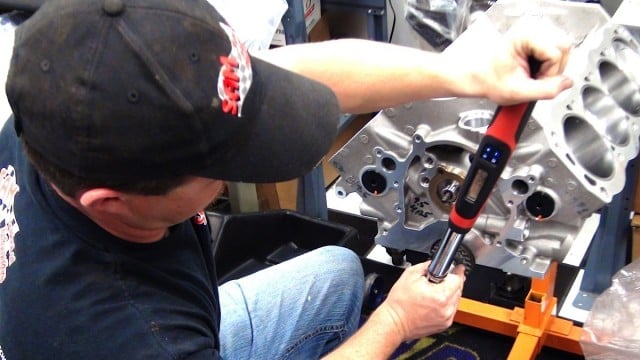 [13]
[13]Ring tension can be tested with a "fish scale," but an easier method is with a torque wrench on the crankshaft.
A much more common method is to use a torque wrench on the end of the crankshaft.
“Some people want to do one piston, some want to do the whole shortblock; doesn’t really matter as long as you do the same each time,” says Massingill. “They’ll measure what it takes to rotate the crankshaft. And this is the ring drag that you have.”
What kind of readings you should expect will vary widely depending on your application.
Top left, a 1/16-inch plasma moly ring. The porosity of the moly is evident in the contrast between the light and dark spots. The shinny part in the middle is where the face has been lapped for quicker seating. Top right is a .7mm ring coated with titanium nitride (TiN). Note the smoother surface. Below are examples of the moly coating peeling away. Photos courtesy of Total Seal
If you put together a stock 400 Chevy, and put standard tension rings in it, it’s probably going to take about 30 to 35 foot-pounds of torque to turn that shortblock,” Massingill said. “If you put it together with the rings that we utilize [for the Engine Masters Competition], it’s going to take about eight or nine pounds. Can you imagine, at 7,000 or 8,000 rpm, the difference that that is? It can easily be 30-35 horsepower.”
There’s another option—call your ring supplier and give them your engine combination in great detail, and let them select. What you’ll get will probably be conservative, in favor of high tension, but if it works well, on the next teardown you can always opt for the next step down in tension.
Still, it’s a delicate balancing act. “We don’t always run the least amount of tension we can, because sometimes that point is hard to find. You don’t know what’s the least amount you can use,” said Chris Bennett, an instructor at SAM.
“We welcome calls and e-mails to you to be sure you’re getting the best possible package for your engine,” sums up Jones. “Lots of pistons come with rings in the box these days, but are they right for what you are doing or do they just happen to fit the bore size? If you are not sure, contact us.”
